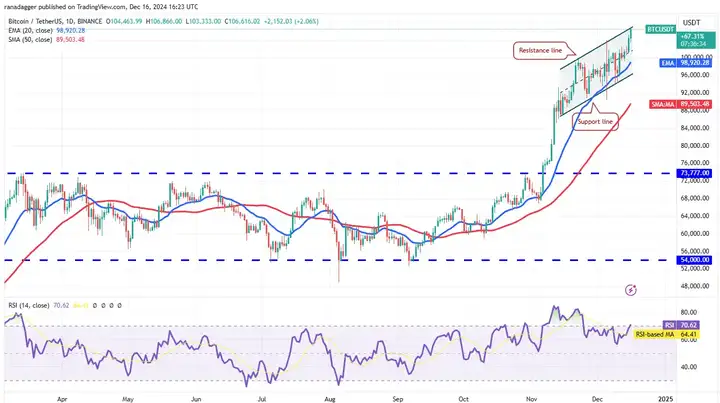Bitcoin experienced violent fluctuations last night (12/17) after the US stock market opened, briefly reaching a new high of around $108,000 before quickly falling more than $2,000. As of the time of writing, it continues to decline, currently quoted at $104,764.
This pullback caused $338 million in liquidations in the cryptocurrency perpetual contract market, with about 140,000 people being liquidated, and the Bitcoin liquidation amount reaching $58 million.
VX: TTZS6308

Bitcoin is currently in the 7th week after breaking its historical high. Based on historical trends, this stage usually carries a risk of correction. Referencing past bull market cycles, Bitcoin's bull markets in 2013, 2017, and 2021 all experienced significant corrections of 16%-34% in the 6th to 8th week after breaking new highs.
If Bitcoin corrects, $98,133 may be a support
Looking at on-chain data, there are over 150,000 BTC held in large positions with an average price around $98,133, which may become a key support level during a correction.

Although it is currently difficult to be bearish on the Bitcoin spot market, the options market has recently been more inclined to sell options (put options) rather than buy options (call options), suggesting that investors are more inclined to hedge risks rather than chase the rally.
Do not be overly concerned about short-term correction risks, as the period from now until the summer of 2025 will be the golden era for the Altcoin market.
Bitcoin is currently near the resistance level of its upward channel. If it can break through the current resistance, the next target price may be $113,331, or even challenge the $125,000 level.
However, if Bitcoin falls below the 20-day exponential moving average (around $98,920), it would indicate that the market has entered a correction phase, and the short-term support line will be around $96,000.

Although Bitcoin faces correction risks, I remain optimistic about its medium to long-term outlook. The short-term volatility is a healthy correction and will not change the overall upward trend. Investors should remain calm, focus on key support levels, and manage risks accordingly.
How about Altcoins?
Bitcoin's capital mainly comes from the support of traditional large capital, while Altcoins are over-issued, randomly issued, and the lock-up positions during the general rise will drain the entire liquidity. It can be seen that even the new coins on the major exchanges basically no longer have the effect of making money, they just drop after being launched, which is enough to show that the liquidity in the market has dried up. At this time, if Bitcoin experiences a correction, it means a comprehensive bloodletting of capital in the market, so for the small coins on the CEX, it is now time to consider risks rather than benefits.
That said, even if Bitcoin continues to rise and breaks through $110,000, small coins will still be in a semi-dead state. For small coins to improve, there must be external capital inflow, or the capital previously locked in Doge, XRP, ETH and other large-cap coins must spill out again. If these things don't rise, Altcoins will be hard-pressed to improve. As for the wealth effect on the chain, everyone needs to rely on their own skills, because what comes quickly also goes quickly, and it is not suitable for all non-professional players. The track is full of full-time scientists, and to compete with them, you not only need professional technology, but also enough time to study.
The conclusion is that the focus now is on when Bitcoin will correct, and all Altcoins should be patiently waited for a dip before participating.
Finally, let's talk about ETH. As the second-largest coin supported by traditional capital, when BTC pulls back, ETH may be relatively stronger. ETH just broke its new high a few days ago, and is less than 20% away from its historical high. When Bitcoin stabilizes, it may be ETH's time to shine. Don't forget, Trump's crypto fund's largest holding is not Bitcoin, but Ethereum, so don't doubt this certainty.






